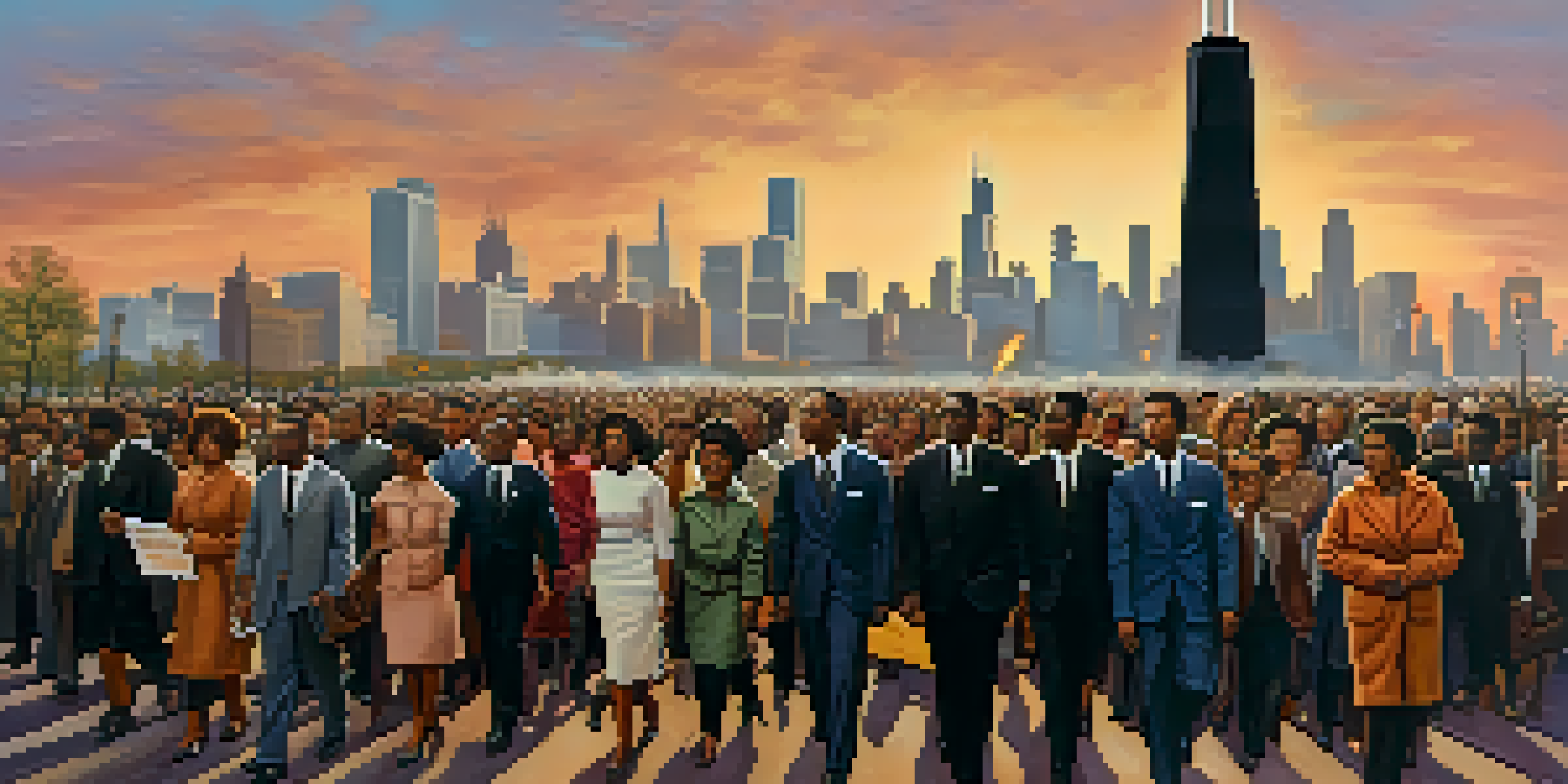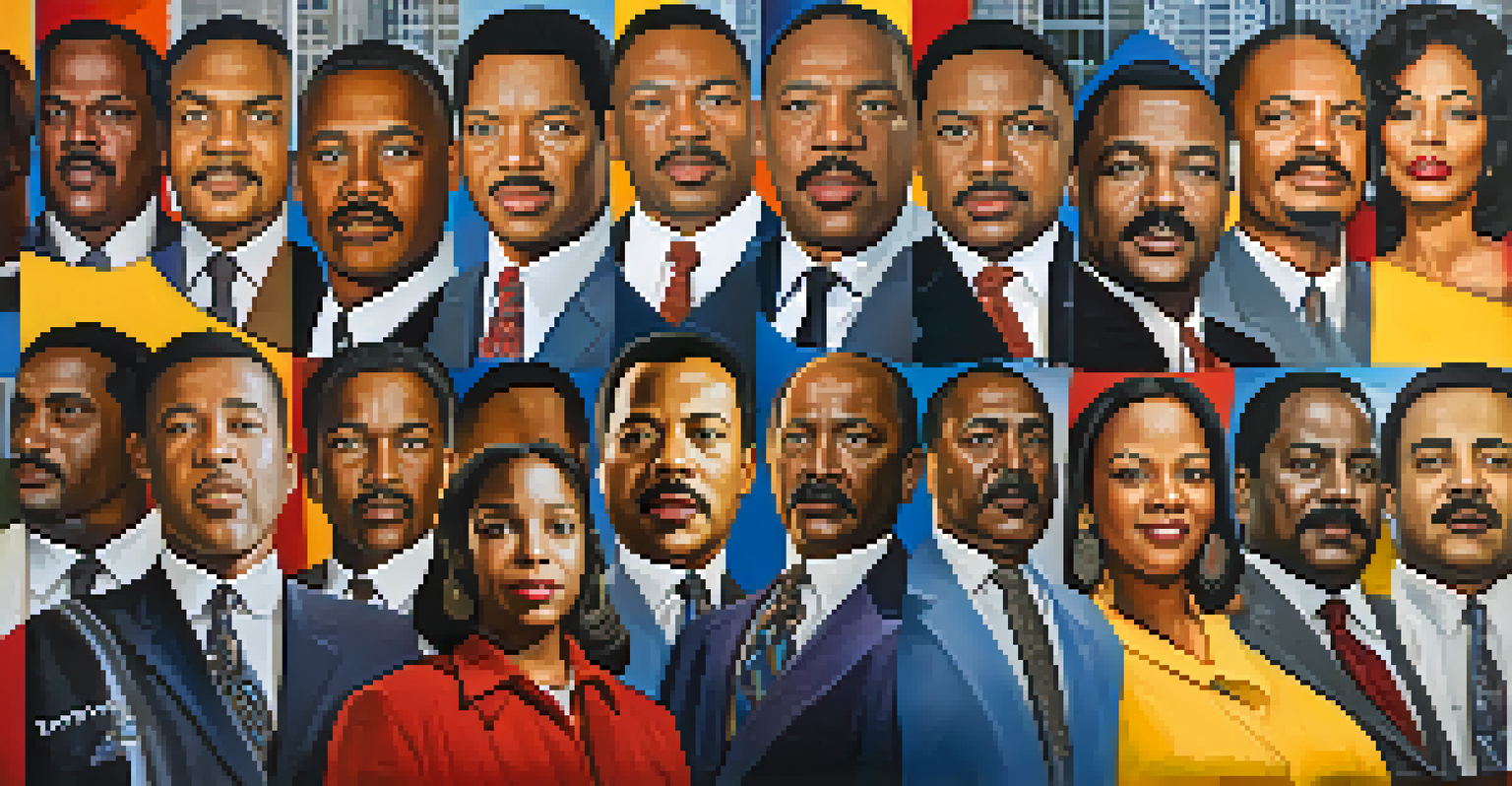Chicago's Role in the Civil Rights Movement: A Historical Overview

The Roots of Civil Rights Activism in Chicago
Chicago's civil rights movement has deep roots, dating back to the early 20th century. The Great Migration brought a wave of African Americans from the South, seeking better opportunities and escaping racial oppression. This influx enriched the city's cultural tapestry while also highlighting the stark realities of segregation and discrimination in the North.
Injustice anywhere is a threat to justice everywhere.
Organizations like the Urban League and the NAACP began to emerge, advocating for equal rights and better living conditions. These groups laid the groundwork for a more organized civil rights movement, uniting individuals from diverse backgrounds in the fight against injustice. The struggles faced by these early activists set the stage for the larger movements that would follow.
Local leaders, such as Ida B. Wells and Louis Farrakhan, played pivotal roles in raising awareness and mobilizing communities. Their efforts not only highlighted the issues within Chicago but also connected the city's struggles to the broader national narrative of civil rights.
Key Events: Marches and Protests in the 1960s
The 1960s were a transformative decade for civil rights activism in Chicago, characterized by powerful marches and protests. One of the most notable events was the 1963 Chicago Freedom Movement, led by Martin Luther King Jr., which sought to address issues of housing discrimination and economic inequality. This movement brought thousands of people together, showcasing the city’s diverse coalition for change.

During this time, King famously led the march on City Hall, demanding fair housing practices and an end to racial segregation. The images of these marches captured national attention, emphasizing the urgency of civil rights issues not just in the South but across the entire country. Chicago became a focal point for civil rights activism, inspiring other cities to take action.
Chicago's Civil Rights Origins
The civil rights movement in Chicago emerged from the struggles of African Americans during the Great Migration, highlighting systemic discrimination and advocating for equal rights.
These demonstrations were met with resistance, often leading to violent confrontations with law enforcement. However, the resilience of protesters highlighted the determination of Chicagoans to fight for their rights, igniting conversations about equality and justice that would resonate for years to come.
Impact of the Chicago Freedom Movement
The Chicago Freedom Movement significantly impacted the civil rights landscape, as it pushed for reforms that went beyond mere desegregation. It aimed to address housing, education, and employment disparities that plagued African Americans in the city. This holistic approach emphasized the interconnectedness of various social issues, showcasing how systemic change was essential for true equality.
The time is always right to do what is right.
One of the major outcomes of the movement was the introduction of the Open Housing Ordinance in 1968, which aimed to eliminate racial discrimination in housing. While the ordinance faced strong opposition, it marked a critical step towards fair housing practices within the city. It also served as a template for similar legislation across the nation.
Moreover, the movement fostered a sense of unity among various civil rights organizations, creating a collaborative spirit that transcended individual agendas. This solidarity not only strengthened the local movement but also influenced civil rights strategies on a national level, showcasing Chicago as a beacon of hope and activism.
The Role of Education in the Movement
Education played a crucial role in the civil rights movement in Chicago, serving as both a battleground and a tool for empowerment. Schools became focal points for activism, with students organizing protests against discriminatory practices and advocating for equitable funding. This grassroots approach inspired a new generation of leaders committed to social justice.
Institutions like the Chicago Public Schools saw significant student-led movements aimed at reforming curricula to be more inclusive and representative of African American history. These efforts not only highlighted the educational disparities but also ignited discussions about the importance of cultural identity in education. The push for educational equity became intertwined with the broader civil rights agenda.
Impact of the Chicago Freedom Movement
The Chicago Freedom Movement sought comprehensive reforms in housing, education, and employment, leading to significant legislative changes like the Open Housing Ordinance.
In addition, colleges and universities in Chicago, such as the University of Chicago and Chicago State University, became hubs for civil rights activism. Students engaged in sit-ins, protests, and teach-ins, fostering a culture of critical thinking and activism that would shape future leaders in the movement.
The Influence of Local Leaders and Organizations
Local leaders and organizations were instrumental in shaping the civil rights movement in Chicago. Figures like Jesse Jackson and the Southern Christian Leadership Conference (SCLC) played vital roles in mobilizing communities and orchestrating campaigns for social justice. Their charisma and commitment galvanized public support for civil rights initiatives.
Community organizations, such as Operation Breadbasket, founded by Jackson, focused on economic justice and job equality. This initiative aimed to improve the economic conditions of African Americans by advocating for fair hiring practices and supporting black-owned businesses. It exemplified how economic empowerment was integral to the civil rights struggle.
Additionally, coalitions formed among various ethnic and religious groups in Chicago, demonstrating the importance of solidarity in the face of oppression. These collaborations not only strengthened the movement locally but also provided a blueprint for future activism that transcended racial and cultural divides.
Legacy of the Civil Rights Movement in Chicago
The legacy of the civil rights movement in Chicago continues to resonate today, influencing contemporary social justice efforts. The struggles and triumphs of activists in the 1960s laid the groundwork for ongoing battles against systemic racism and inequality. Their achievements serve as a reminder of the power of grassroots organizing and community engagement.
Moreover, the lessons learned from Chicago's civil rights movement have been applied to various social movements that followed, including those advocating for LGBTQ+ rights, immigrant rights, and environmental justice. The interconnected nature of these struggles underscores the significance of intersectionality in activism, illustrating how different forms of oppression are often linked.
Modern Activism Inspired by History
Contemporary movements in Chicago, such as Black Lives Matter, draw inspiration from historical civil rights struggles, emphasizing the importance of ongoing activism against systemic racism.
Today, organizations in Chicago continue to honor the legacy of the civil rights movement by advocating for equitable policies and fighting against discrimination. The city remains a vibrant center for activism, reminding us that the fight for justice is ongoing and that every voice matters.
Chicago’s Modern-Day Civil Rights Activism
In recent years, Chicago has seen a resurgence of civil rights activism, driven by a new generation of leaders and advocates. Movements like Black Lives Matter and grassroots organizations have mobilized thousands in response to police violence and systemic racism. This contemporary activism draws inspiration from the historical struggles faced during the civil rights movement, emphasizing the need for ongoing vigilance and action.
The digital age has also transformed activism, as social media platforms allow for instant communication and mobilization. Campaigns can now reach wider audiences, enabling a more significant impact and fostering a sense of global solidarity. Chicago activists have effectively used these tools to raise awareness and advocate for change, proving that the spirit of the civil rights movement endures.

Ultimately, the ongoing fight for equality in Chicago serves as a testament to the resilience and determination of its residents. The city’s past offers valuable lessons for current and future activists, reminding us that the work of justice is never complete and that every action counts in the pursuit of a more equitable society.